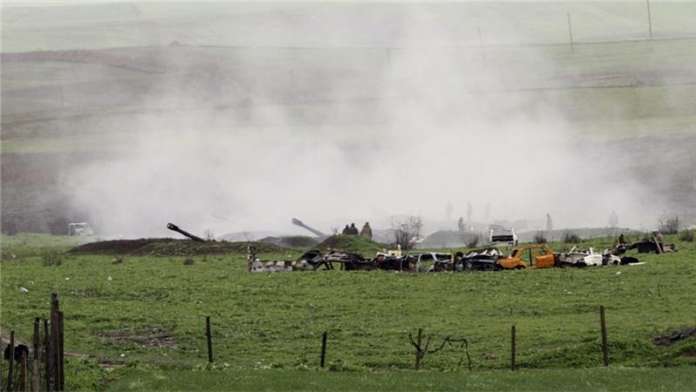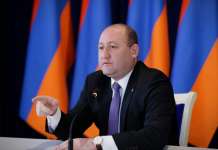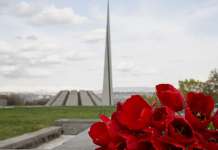YEREVAN – Renewed fighting has rocked the self-proclaimed Nagorno Karabakh Republic. On the night of April 1st-2nd, the Azerbaijani Armed Forces, with helicopter and drone support, launched a coordinated assault against Nagorno Karabakh Defense Army positions around Martakert in the north, and Hadrut to the south,
Sequence of events:
On the morning of April 2, Armenians woke up to news of an armed assault on Karabakhi positions, costing the attackers one helicopter and one drone in the process. 1 Karabakhi Armenian child was killed and two wounded in an Azerbaijani artillery strike, but accurate updates were difficult to come by throughout the day as reports of renewed hostilities contributed to tension felt in the air throughout the capital, Yerevan.
Claims that the Azerbaijani military had captured the small village of Talish, some 300 meters from the Line of Contact (LOC) near Martakert were initially denied, and later confirmed by the Nagorno Karabakh Ministry of Defense. Both sides claimed successes and heavy casualties against the other amid heavy and confused fighting throughout the day. The Azerbaijani military claimed 13 personnel Killed in Action (KIA) while Armenian President Sargsyan, fresh from a visit to Washington DC, announced the death of 18 Karabakhi Armenian servicemen. The NKR’s Ministry of Defense did release drone footage discernibly showing bodies of at least two dozen Azerbaijani soldiers spread throughout a section of the line of contact, as well as pictures of destroyed azerbaijani military equipment.
By the morning of April 3, the NKR’s Ministry of Defense reported that it had launched a counteroffensive which recaptured the village of Talish and the surrounding area. That same day, HETQ.am photojournalist Hakob Poghosyan made a gruesome discovery in one of the houses newly retaken from the Azerbaijani army. The bodies of pensioners Valera Khalapyan, and his wife Razmela, were found in their living room, with their ears cut off, apparently having been executed by occupying Azerbaijani soldiers. The body of Marousya Khalapyan was also found nearby, murdered in the same fashion, sparking outrage in Armenia.
By midday on the 3rd, an azerbaijani government spokesman announced a unilateral ceasefire, reportedly stating “Azerbaijan, showing goodwill, has decided to unilaterally cease hostilities,”. This confusing claim was repudiated by the Nagorno Karabakh government which cited sustained shelling of Martakert by Azeri Grad missiles. This was confirmed on the ground by Civilnet reporter Tatoul Hakobyan who was caught under an artillery barrage.
News of continued fighting in the region galvanised the Armenian population. Armenian military recruitment centres, as well as the “Yerkrapah” militia leaders reported being overwhelmed by volunteer applications, which included Karabakh War veterans, as well as repatriates from Canada, Syria, and Russia.
Russian-born Ani Margaryan, loading an AK-74 rifle at an Army Recruitment Centre was quoted as saying “I moved to Armenia because I wanted to live in my homeland. If need arises, I will stand by my brothers. Every woman must be ready to pick up a rifle to protect our country”.
American University of Armenia’s Student Council set up a news translation station on campus to quickly spread reports from the front in 12 languages, while students from the Yerevan State University, and State University of Economics set up collection points, accepting food, warm clothing, medical supplies and other items for soldiers serving in Karabakh. An impromptu drop off point was also set up by volunteers in downtown Yerevan’s Mashtots Park. A hacker group going by the name “Monte Melkonian Cyber Army” hacked a number of Azerbaijani government websites, including the Azeri ambassador to Moscow’s official Twitter account.
A Karabakh Defense Force counteroffensive continued throughout the night of the 3rd and 4th of April, reportedly succeeding in pushing back Azeri units to their point of origin, amid pressure by international organisations, including the United States, the Russian Federation, the OSCE, and the European Union for hostilities to cease. The Conservative Party of Canada called for the Trudeau government to condemn Azerbaijan’s belligerent actions. By the evening of the 4th, the Karabakh Ministry of Defense announced the recapture of all but eight military posts along the LOC, at the cost of 40 soldiers, four civilians, 72 wounded and 26 missing. The loss of seven tanks was also reported. The spokesperson also estimated that the Azerbaijani military had lost 28 tanks, 2 drones, and over 300 soldiers (a claim mirrored by the Azerbaijanis).
The lack of reliable information, and a slue of propaganda on all sides has made it difficult to confirm much of this information.
Tensions increased further throughout the night of April 3rd, with the reported deployment of Russian-manufactured Smersh and TOS-1 missile systems by Azerbaijan, backed by threats against Karabakh’s capital of Stepanakert. The destruction of a minivan carrying volunteers from the town of Sisian by the Israeli-built “Harop” Kamikaze drone constituted the first ever use of this weapon. Evidence of the use of cluster munitions by Azerbaijani forces, considered a war crime by the 2010 Dublin Convention, has also been uncovered by journalists on the ground.
The Deputy Defense Minister, Mr. David Tonoyan announced the total recapture of all military posts along the Line of Contact at a press conference held on the morning of the 5th of April. Within hours, a ceasefire was agreed upon, effective at 12:00pm Yerevan time, which is still holding at the time of writing.
Context:
As the unresolved Nagorno Karabakh conflict enters its 22nd year, Azerbaijani frustration at the diplomatic stalemate has manifested itself in ever more explicit threats of violence, with numerous Azerbaijani officials, including President Aliyev threatening to “Retake [the region] by force”. This has translated into serious breaches of the 1994 Bishkek agreement with an increasing level of violence on the LOC. An Armenian shift in doctrine towards stronger responses to Azerbaijani provocation has lead many observers to warn that the situation can become explosive if unaddressed by the International Community. The continued deadlock over the region’s status has also been linked to a lack of democratic reform, and corruption as illiberal regimes in both countries benefit from the status quo.
Azerbaijani Petrodictator, Ilham Aliyev in particular, who took over from his father, former-Soviet strongman Heydar Aliyev, has used the Karabakh conflict as a lightning rod for frustration, turning the dehumanization of Armenians into an official state policy as oligarchs linked to his family siphoned the country’s oil wealth through elaborate money laundering schemes.
Azerbaijan, which boasted of a military budget higher than Armenia’s entire state budget, has been using oil revenue to buy up sophisticated military systems from Armenia’s main strategic partner Russia, all the while failing to diversify the country’s economic output.
The recent drop in global oil prices has hit the Azerbaijani economy particularly hard, as the national currency, the Manat, devalued by almost 70% over the course of last year. The Azerbaijani government has implemented austerity measures for the first time in it’s history, and applied for emergency support from the International Monetary Fund. The sudden cut to pensions for many Azeris, and falling living standards amid growing accusation of large-scale corruption by the ruling family has contributed to instability in the country, which the government has responded to with brutal suppression, as well as persecution of opposition activists and journalists.
Many have linked the timing of this new attack with the publishing of leaked documents implicating the Aliyev family in a number of offshore shell companies in Panama, shedding further light on the extent of corruption in this newly bankrupt country.
Analyst Richard Giragosian, director of a Yerevan-based independent think tank, theorised that the attack was premeditated and would have been ordered while Aliyev was either still in Washington DC attending a nuclear summit along with his Armenian counterpart.
Speaking from Berlin at a press conference with German Chancellor Angela Merkel, President Sargsyan called on the international community to recognise Karabakh’s right to self determination.
The extremely slow response, and subsequently vague response of the OSCE Minsk group, formed by France, the United States and Russia to preserve the ceasefire, has prompted calls to revamp current peace negotiation mechanism which is now seen as obsolete. Richard Giragosian explains that the international community has little means of deterrence of leverage on Azerbaijan to bring it back to the negotiating table. Failure to do so may all but guarantee renewed conflict. A second war, Giragosian surmises, may be necessary in order to decisively dispel any ambitions Azerbaijan may have to the region.
With news of the ceasefire holding, the mood in Yerevan and Stepanakert is a mix of anguish, patience, defiance, and optimism.
Raffi Elliott











